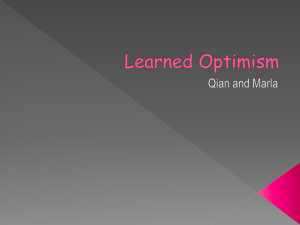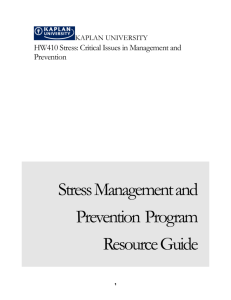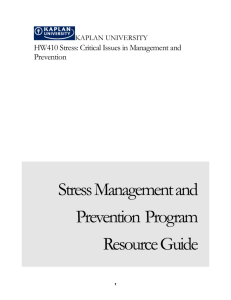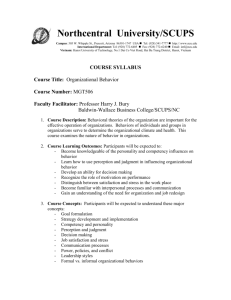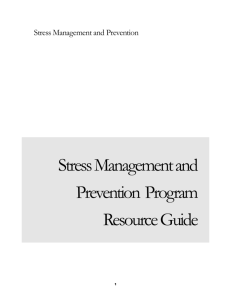KAPLAN UNIVERSITY
advertisement
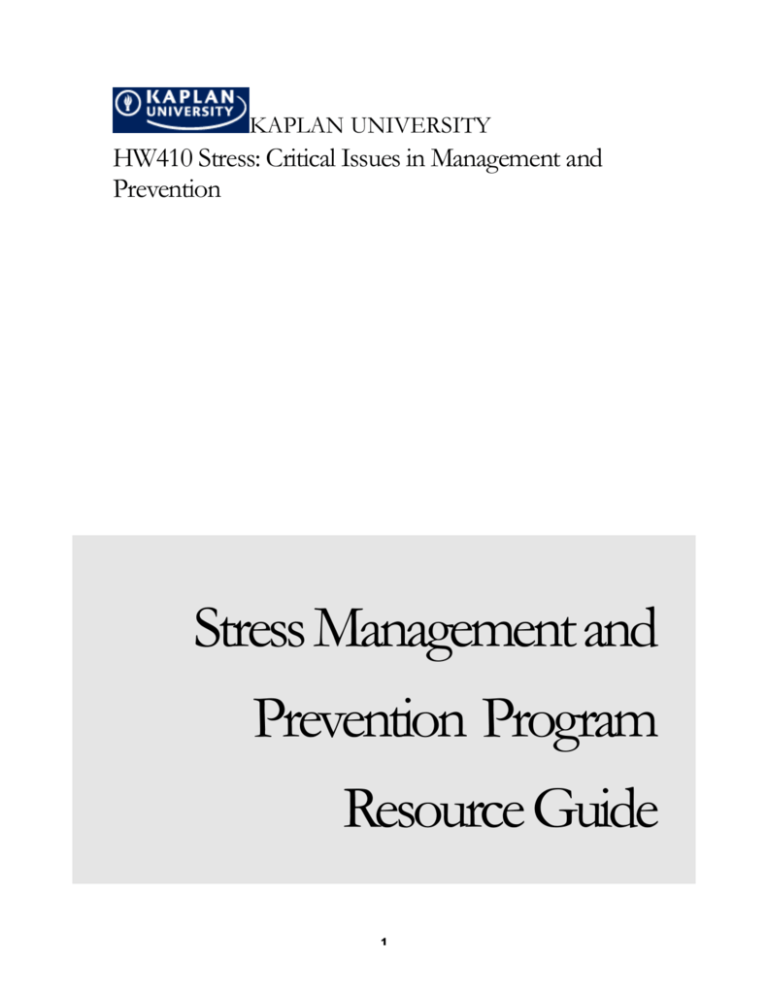
KAPLAN UNIVERSITY HW410 Stress: Critical Issues in Management and Prevention Stress Management and Prevention Program Resource Guide 1 KAPLAN UNIVERSITY Stress Management and Prevention Program Resource Guide By Annette Griffus Kaplan University HW410: Stress: Critical Issues in Management and Prevention August 6, 2014 Table of Contents UNI T 1 THE NATURE OF STRESS Information to Remember Resources: Exercises: Exercises Tools: Journal Writing: Journal Writing UNI T 2 THE BODY AS BATTLEFI ELD Information to Remember Resources: Exercises: Exercises Tools: Journal Writing: Journal Writing UNI T 3 FEAST OR FAMI NI NE Information to Remember Resources: Exercises: Exercises Tools: Journal Writing: Journal Writing UNI T 4 ONE PLANET UNDER STR ESS Information to Remember Resources: Exercises: Exercises Tools: Journal Writing UNI T 5 UNDER STRESS: WHAT N OW? Information to Remember Resources: Exercises Tools: Journal Writing UNI T 6 AGELESS WI SDOM OF MEDITATI ON Information to Remember Resources: Exercises Tools: Journal Writing UNI T 7 SI GHT, SOUND, Information to Remember Resources: Exercises Tools: Journal Writing AND BO DY WORK UNI T 8 THE WELLNESS MANDALA Information to Remember Resources: Exercises Tools: Journal Writing UNI T 9 APPLYI NG PREVENTI ON TO STRESS: YOUR CRI TICAL P ROFESSI ONAL MANAGEMENT AND LI FE Information to Remember Resources: Exercises Tools: Journal Writing UNI T 10 APPLYI NG PREVENTI ON TO STRESS: YOUR CRI TICAL P ROFESSI ONAL MANAGEMENT LI FE Information to Remember Resources: Exercises Tools: Journal Writing ADDI TI ONAL I NFORMATI ON (End of the Guide) AND (This page intentionally left blank) 1 Unit Unit 1: The Nature of Stress Information to Remember: What is stress? Stress is the experience of a perceived threat (real or imagined) to one’s mental, physical or spiritual well-being, resulting from a series of physiological responses and adaptations. There are three types of stress: eustress, neustress and distress. Eustress is good stress and arises in any situation or circumstance that a person finds motivating or inspiring. Example: falling in love or meeting a professional athlete. Neustress describes sensory stimuli that have no consequential effect, it’s neither good nor bad. The third type, distress, is bad and often is abbreviated as stress, which is either acute – that which surfaces, is intense and disappears quickly – or chronic, which is not so intense but lingers for prolonged periods of time, hours days, weeks or months (Seaward 2008). Physical effects of stress: Forty-three percent of all adults suffer adverse health effects due to distress. Seventy-five to 90 percent of all visits to primary care physicians are for stress-related complaints or disorders. Stress has been linked to heart disease, cancer, lung ailments, accidents, cirrhosis and suicide (Seaward 2008). Obesity is also linked to stress thanks to the hormone cortisol, something that I struggled with in my fight with being obese. I feel much healthier overall because I exercise daily and can relieve daily stress that would otherwise accumulate quickly. Stress can be reduced dramatically under a wellness paradigm, in other words, total wellness is the balance, integration and harmony of the physical, intellectual, emotional and spiritual aspects of the human condition (Seaward 2008). Prayer, exercise, even something as simple as unplugging from all electronic devices for an hour a day will greatly reduce everyday stress. Resources: Exercises: A good way to begin to reduce stress in your life is to find out what is your health philosophy. In your opinion, what does health and wellness mean to you? What would you like it to be? How can you change it? How is your health and wellness influenced by stress? Write down your top 10 stressors and the ways you and your family can start to eliminate these stressors. 4 Tools: Journal Writing: A good way to figure out where stress might be effecting you the most is to keep a journal. Write down what your reactions are to times of stress: Do you eat? Do you have trouble sleeping? Do you become unreasonably angry? Keep a journal for a week and see what, if any, patterns develop. 5 2 Unit Unit 2: The Body as Battlefield Information to Remember: As previously stated in Unit 1, there is a clearly defined relationship between chronic stress and excessive wear and tear on the body. Three systems are directly involved with the physiology of stress: the nervous system, the endocrine system and the immune system (Seaward 2008). Allostatic load is a term coined by stress researcher Bruce McEwen to replace the term “stressed out”; the damage to the body when the allostatic response functions improperly or for prolonged states, causing physical damage to the body (Seaward 2008). I’m sure like everyone else, I have been “stressed out.” In the past I didn’t know how to handle it, however, with increased knowledge of learning how to respond to stress points, you can manage your stress and decrease the allostatic response functions by your body. Multitasking, while exalted by today’s busy world, is not beneficial to relieving stress. It is just the opposite, especially for youths up to age 22 and adults over the age of 60. Studies have revealed that when young adults perform two or more tasks simultaneously, the amount of errors increases dramatically. It should also be noted that with the rise of electronic devices being used in the household, face-to-face interaction between family members, including children, is dwindling. Children need positive, physical contact and reaffirmation daily to develop and decrease stress (Seaward 2008). It is more beneficial to have face-to-face contact with your family members, rather than talking via text or social media. You cannot develop strong, healthy relationships over the Internet. Resources: Exercises: Immediate, intermediate and Prolonged Stress Effects: In relation to Unit 1, write down how your body reacts to immediate stress. Do your symptoms include tingling sensations, sweating, muscle tension (e.g., jaw muscles), a rapid heart rate? How would you describe your body’s intermediate (within hours) response to stress? Tension headache, sore neck and shoulders, allergies, stomachache? It’s good to know how you react to different situations so that you can adapt to them and do your best to add some control back into the situation. 6 Tools: Journal Writing: Stress Physiology Review: It’s beneficial to understand the physiology of stress so that during times of stress you can augment your ability to conquer it with a deeper sense of relaxation and healing. Understanding different hormones (e.g., corticotrophin, thyroxine, epinephrine) allows one to sense how and when to try and alleviate stress (Seaward 2008). For this journal entry, when are you most stressed and what is your body’s physical reactions? How do you normally combat it? 7 3 Unit Unit 3: Feast or Famine Information to Remember: Psychosomatic is a term coined by Chicago-based physician Franz Alexander. The term describes the precarious mind-body relationship. Alexander observed there appeared to be a profound connection between one’s mental/emotional state and one’s physical health (Seaward 2008). In other words, can you talk yourself into a cold if you are over-stressed at work or home? Psychoneuroimmunology (PNI) is the study of the intricate interaction of consciousness (psycho), brain and central nervous system (neuro), and the body’s defense against external infection and internal aberrant cell division (immunology) (Seward 2008). The purpose of the immune system is to protect the body from pathogens, either externally or internally. An improperly functioning immune system can lead to chronic illnesses, colds/flus, heart disease, diabetes and cancer. In fact, Western researchers discovered that emotional stress can produce symptoms of a heart attack as stress hormones might temporarily overwhelm heart cells (Seaward 2008). Resources: Exercises: Anger Recognition Checklist: A quick exercise to help understand how anger can surface in a normal day and contribute to elevated stress levels and how many people mismanage their anger. This is a beneficial self-assessment designed to track how one reacts with anger; such as trouble sleeping, exploding in rage, cold withdrawal, hostile joking, sulking, abuse of alcohol/drugs, etc. There are correct ways to deal with anger. Examples would be to take a time-out from the situation, pause/think before speaking or responding to someone else who is angry, plan several options for a situation, and lower expectations (Seaward 2008). Tools: Journal Writing: In your journal, go back to the top 10 stressors that have the most influence in your life. Assess how you handled them the first week. Now, based on new techniques and ways to manage the same stress. How is it different? What benefits did you learn? 8 4 Unit Unit 4: One Planet Under Stress Information to Remember: Personalities can determine stress reaction and response. The Type A (or aggression) personality was once associated with time urgency, but is now associated with unresolved anger issues. It has greater health risks such as hypertension as well as coronary heart disease (Seaward 2008). Traits for the Type A include gaining material wealth, immediate gratification, competitiveness, seeing people as numbers, secularization, atrophy of the body and right brain and television watching (Seward 2008). The Type D (depression) personality that associates anxiety and depression affect the course of heart disease. Among the Type D is codependency, which is an addiction to another person and their problems or to a relationship and its problems (Seaward 2008). The helpless-hopeless personality is a stress-prone personality based on low self-esteem. Learned helplessness are poor self-motivation, cognitive distortion and emotional dysfunction (Seaward 2008). The hardy personality has characteristics that, in combination, seem to buffer against stress; control, commitment and challenge (Seaward 2008). A trait that is common to all personalities is self-esteem. It appears to be a critical factor in how people respond to stress, regardless of personality type. Low self-esteem is more common in Type A, codependent and helpless-hopeless types; high self-esteem seems to be a prerequisite for creating stress-resistant personalities while self-esteem in general is described as the harmony or discrepancy between actual self-image and ideal self-image (Seaward 2008). Resources: Exercises: Stress and personality: What characteristic make up a Type-A personality, a hardy personality and a Type D personality. Where do you fit in? How would you go about trying to change your personality from a Type A to a hardy? What benefits would you see in doing so? Tools: Journal Writing: Distractions of the human path: Distractions can best be described as those things that pull us off the spiritual path indefinitely. They begin as attractions but their allure can often cast a spell of laziness on the soul-growth process (Steward 2008). Take a moment to reflect on some distractions in your life. 9 Make a list and describe each one in a sentence or two. Upon reflection, what steps can you take to wake up and get back on the path? (Steward 2008). 10 5 Unit Unit 5: Under Stress: What Now? Information to Remember: Behavior modification model: While it might seem counter-productive, denial in some cases is the first step toward changing a negative behavior. Other stages include awareness, desire to change, cognitive restructuring, behavioral substitution and evaluation (Seaward 2008). Each stage can give an individual both motivation and at times some setbacks, but each one is crucial to creating a behavior that is positive and healthy. Humor therapy: It’s been believed throughout time that having a positive outlook and humor can help lead to a healthy life. “A merry heart doeth good like a medicine, but a broken spirit drieth the bones.” (Proverbs 17:22). While humor is not itself a positive emotion, it can elicit positive emotions, including happiness, joy, love, faith, hope and willpower. Humor is the one defensive mechanism that can increase pleasure and reduce pain at the same moment. That is why many people turn to humor during times of extreme stress, such as a loved one in a hospital (Seaward 2008). Humor therapy as a coping technique allows individuals to relieve and reduce emotional stress by focusing on the funny, humorous and positive aspects of life (Seaward 2008). Resource management: Bad money management and bad time management are sure-fired ways to increase ones stress. The average American has 2.5 credit cards with approximately $5,000 in debt and little to no savings (Seaward 2008). Budgeting your time and money is crucial in relieving stress and increasing overall health. Some simple rules will help in this regard; make a budget and follow it, don’t spend what you don’t have, pay all your bills on time, put away at least 10 percent of your monthly income into a savings account and don’t touch it (Seaward 2008). Resources: Exercises: A bigger, clearer perspective: Creating a personal budget and staying committed to it is a must-do for all adults. For couples, take the time to sit down together and go over your income, expenses and how you plan for your future and your children’s future. Once established, don’t become distracted! Stick with it and you’ll see the benefits quickly. 11 Tools: Journal Writing: Value assessment and clarification: Throughout our lifetime we construct a value system, a collection of values that influence our attitudes and behaviors, all of which make up our personality (Seaward 2008). With that in mind, make a list of core values you hold; see if you can identify which of these values are basic, or instrumental at this point in your life and which support or augment your basic values; how are your values represented in your possessions; describe how your values influence your dominant thoughts, attitudes and beliefs; do you have any values that compete for priority with one another and if so, what are they, and why is there a conflict? Also, what do you see as the best way to begin to resolve this conflict in values? Ask yourself whether it is time to change the priority of your values or perhaps discard values that no longer give importance in your life. 12 6 Unit Unit 6: Ageless Wisdom of Meditation Information to Remember: Prayer is essential in keeping the mind-body connected. The Lord created us to worship him and by doing so we achieve a sense of calm and peace that is unmatched by any other means. Because the Bible is God’s word come to life, He tells us 365 times “Don’t worry.” A verse that I remember frequently is Matthew 11:28: “Come unto me, all ye that labour and are heavy laden, and I will give you rest.” Several studies have shown that those who are more spiritual and pray often are less stressed during difficult times and visit doctors less (Borchard 2010). Diaphragmatic breathing is the most basic relaxation technique; breathing from the lower stomach or diaphragm rather than the thoracic (lung) area (Seaward 2008). I find this to be of great help during times of stress. Take three deep diaphragmatic breaths when you know that a stressor is coming, such as public speaking, or having a difficult conversation with a loved one. That moment, along with prayer, can help relieve stress at that time. Massage therapy is terrific in relieving muscle tension, a premier symptom of the stress response. A professional massage is defined as the manipulation of skin, muscles, ligaments and connective tissue for the purposes of decreasing muscle tension and increasing physical comfort of musculature and its surrounding joints (Seaward). I find massage therapy to be extremely beneficial in relieving stress, no matter if it’s 15 minutes or 60 minutes. The massage oils used by the therapist are aromatic and also assist in stress relief. Resources: Exercises: Bridging the Hemispheres of Thought: Knowing and understanding left-brain and right-brain dominance is helpful in understanding how our minds work. Left-brain thinking skills are associated with judgment, analysis, mathematical and verbal acuity among others while right-brain thinking encompasses humor, global thinking, imagination, and intuition among others. Which one are you? Is it possible to have both? Biofeedback exercises: For this exercise, count the number of breaths you take while breathing normally in a one-minute period. In a normal resting state it should be somewhere around 60-70 13 beats per minute. Next, using diaphragmatic breathing for one minute, retake the normal breath test and note the difference. Tools: Journal Writing: Too much information: In the time of the information age of satellite television, cable, Internet, smartphones and embedded computer chips in just about everything we own it is critical that we take a step back from all the information we are inundated with 24/7. Over 80 percent of the information we take in is through sight and sound and therefore it is common to feel bombarded and have sensory overload (Seaward 2008). In this journal entry, list five ways you can successfully decrease the quantity of information you are barraged with every day. What are a handful of ways you can bring balance back into your life by taking time to quiet your mind and explain them. 14 7 Unit Unit 7: Sight, Sound and Body Work Information to Remember: Nutrition and diet is usually the first thing that suffers when we are over-stressed. Food becomes a pacifier and is a coping technique that is often abused. There are four dominos that alter nutrition due to stress; 1, stress tends to deplete nutrients in the body; 2, current American lifestyles under stress do not promote or reinforce good eating habits (junk food vs. healthy food); 3, some food substances are known to increase physiological responses that keep the stress response elevated; 4, many foods that are processed contribute to a cumulative effect of toxins (Seaward 2008). Genetically altered foods can be found in over 70 percent of foods found in grocery stores and are detrimental to one’s health. In the last 20 years, corporations like Monsanto and Dow AgriChemical began inserting GMOs in the American food supply without consumer knowledge and backed by the federal government, the increase of food allergens in the past 20 years has skyrocketed. Foods such as wheat, corn and soy are the leading cause of allergies such as gluten intolerance and sensitivity, Celiac’s disease, IBS, and leaky gut syndrome. GMOs are best to be avoided at all costs. Recommendations for healthy eating habits are simple if you take a step back and look at the big picture. Just like we are bombarded with too much information in all walks of our life, nutrition and making good eating choices often seem difficult. However, if you think about it, eating well is easy. The first step is thinking color. Eat fresh vegetables and fruits in a wide variety of colors that are in season; next, protein is essential and should include chicken, fish, grass-fed beef, legumes and beans, yogurt and cheese. Quality grains like quinoa is a better choice than wheat because all wheat is a GMO-hybrid and extremely unhealthy. Good fats include olive, sesame, coconut oils and avocadoes. Tips to remember include shopping the outside of the story, avoiding foods that are packaged and shopping more frequently. Remember this acronym: Don’t eat CRAP. Carbonated drinks, Refined sugars and flours, Additives, Processed. Resources: Exercises: Self-Assessment: Nutritional Eating Habits. Take this test to see how you rate in terms of nutrition. Answer each with a yes or no. Do you regularly consume caffeine? Do you take vitamin/mineral supplements and if so what kinds? Do you eat one or more meals that are prepared outside the home daily? Do you consume junk food regularly? Do you eat cereals that contain sugar? Do you drink a lot of soft drinks? Do you find that when you are stressed you tend to eat more? Do you find that 15 when you are stressed you tend to eat more? Do you eat a wide variety of fruits and vegetables? Do you eat foods (fish and nuts) with essential oils (omega-3, omega-6)? Do you tend to eat quickly? Do you tend to drink alcohol as a means to relax? List your top five comfort foods, when and why you reach for those foods first. Tools: Journal Writing: Stress-related eating behaviors: Please rate on a scale of 0-never to 4-always the following questions: I tend to skip breakfast on a regular basis. On average, two or three meals are prepared outside the home each day. I drink more than one cup of coffee or tea a day. I tend to drink more than one soda/pop per day. I commonly snack between meals. When in a hurry, I usually eat at fast food places. I tend to snack while watching television. I drink fewer than eight glasses of water a day. I tend to satisfy my sweet tooth daily. When preparing meals at home, I usually don’t cook from scratch. Honestly, my eating habits lean toward fast, junk or processed foods. I eat few than four to five servings of fresh vegetables per day. I drink at least one glass of wine, beer or alcohol a day. My meals are eaten sporadically throughout the day rather than at regularly scheduled times. I don’t usually cook with fresh herbs and spices. I usually don’t make a habit of eating organic fruits and veggies. My biggest meal of the day is usually eaten after 7 p.m. For the most part, my vitamins and minerals come from the foods I eat. Artificial sweeteners are in many of the foods I eat. If you scored more than 20 points it indicates an eating behavior that is not conducive to reducing stress. A score of 30 or more and your eating habits may seriously compromise the integrity of your immune system (Seaward 2008). 16 8 Unit Unit 8: The Wellness Mandala Information to Remember: The benefits of physical exercise and activity in relation to stress management is immeasurable. Physical exercise strengthens the integrity of the body’s physiological systems. Just like physical deterioration from chronic distress has negative effects on the body, habitual exercise will allow the body to adapt to good stress (Seaward 2008). Physical exercise is not only good, it is a necessity to maintain proper function of major physiological systems. While the body requires a state of calmness (or homeostasis) it also requires physical stimulation or it will go into dysfunction (Seaward 2008). Exercise needs to be done daily to see the full benefits. A single bout of exercise lasts approximately 36 hours and if a training program is interrupted or discontinued for longer than two weeks, about 10 percent of cardiovascular gains are lost. In other words, use it or lose it (Seaward 2008). Some of the benefits psychological benefits of habitual exercise include improved self-esteem, mental alertness, increased perceptions of acceptance by others, decreased feelings of depression and anxiety, decreased overall sense of stress and tension (Seaward 2008). If someone shies away from exercise due to chronic pain or a low-back injury, Pilates may be the answer. Pilates is a form of muscle strength and flexibility exercises that strengthen the core muscles of the body’s frame (Seaward 2008). Resources: Exercises: Physical Exercise: Describe your exercise habits, including the formula for success (intensity, frequency, and duration). What are your favorite activities? Do you have a second option? What do you do to motivate yourself when you are less inspired to get up and get out? What are your priorities in terms of your health? (Seaward 2008). Here’s a weekly program of exercises that can be done at home or at the gym: Day 1, 15 minute cardio workout (high intensity). Begin with warm up and follow with a cool down stretching program. Day 2, home strength training class via Hasfit.com (warm up and cool down). Day 3, Ultimate 10 minute cardio exercise (warm up and cool down). Day 4, OFF (active rest day, walk, bike, swim, hike, etc.). Day 5, Lose belly fat part 1 and six-back abs in five minutes (with warmup and cool down). Day 6, 15 minute dumbbell strength training (warm up and cool down). Day 7, Lose belly fat part 2 and six-pack abs in three minutes (warm up and cool down). 17 Tools: Journal Writing: In your journal, write down how you feel about your current body, your physique? What do you like about it and explain why? Make a list of things you’d like to improve. Next, do you compare yourself to others? Is your weight a concern for you from a strictly health perspective (not for vain or selfish reasons)? In order to make the change within, what can you think to do to change perceptions, attitudes and beliefs that you have to make your physique the long-lasting one that makes you feel content? 18 9 Unit Unit 9: Applying Stress: Critical Management to your Professional Life Information to Remember: Information seeking is a valid defense against stressors. The process involves collecting and processing facts about a stressful event or situation, which then can be used to help solve the problem and regain emotional stability (Seaward 2008). One of these stressors is the fear of the unknown. In 1998 I was diagnosed with ovarian cancer. It wasn’t the diagnosis itself that caused stress in my life, but the unanswered questions of what will happen next in terms of surgery or therapies. I had a strong support group in my family and close friends that helped me through that time. Social support groups are strong mechanisms for relieving stress. Research has also shown that feelings of connectedness, belongingness and bonding arises from social contact contribute to one’s health. This is the social well-being aspect of spiritual well-being (Seaward 2008). One reason it works is the buffer theory, which suggests that social support acts as a buffer against stress, in that social ties tend to filter out the deleterious effects of both ordinary hassles and devastating life events (Seaward 2008). The premise of prayer as a coping technique to relieve stress is faith. Faith is the belief that each person is connected to a divine source, in my case The Lord Jesus Christ, (Seaward 2008). Several studies have shown that those people who pray and have a strong faith suffer less from loneliness, depression or insomnia (Seaward 2008). Resources: Exercises: Relaxation Survival Kit: This is a must do. Your personal survival kit can incorporate each of the five senses that help you to relax. Examples can be a good chocolate bar (taste), an essential oil or bath salts (touch, smell), a favorite relaxing CD mix (sound) and a good book by an author you enjoy or a funny movie (sight). Other items that bring you a sense of joy or calmness could be a family photo album, a cozy blanket or giving your best friend a phone call. 19 Tools: Journal Writing: Creating a stress management program can certainly not be done as a one-sized fits all approach. No one relaxation technique works for everyone, nor is one coping strategy applicable in every stressful situation. For this journal entry, create your own stress-management program by initiating these steps; 1, make a habit of spending quality time each day for yourself (journal writing, art, music, exercise). 2, make a habit of reading your emotional state (recognize the times when you feel angry, anxious, frustrated and guilty. Ask yourself why, what triggered this response? Find and make the time to work on your humor therapy and laugh each day. 3, practice unconditional love (say hello, smile, share a joke or song, give positive feedback to those around you). 4, nurture your creative skills (play with your children, pets, etc.). 5, balance all components of your well-being and take time to nurture them (learn to express your thoughts and emotions in a therapeutic and diplomatic way) (Seaward 2008). 20 10 Unit Unit 10: Applying Stress: Critical Management to your Personal Life Information to Remember: Tense, sore muscles are the first indication of stress. It is the most common symptom and in extreme cases it can distort and disalign posture and joint stability. Symptoms of muscle tension include tension headaches, stiff necks, lower-back pain, stomach cramps and some forms of temporomandibular joint (TMJ) dysfunction (Seaward 2008). From my own view I know this to be true as I will occur a stiff neck, upper and lower-back pain if under stress that is work-related. Progressive muscular relaxation (PMR) is a technique specifically designed to help reduce muscle tension. PMR is a relaxation technique; tensing and then relaxing the body’s muscle groups in a systematic and progressive fashion to decrease muscle tension (Seaward 2008). The physiological benefits of PMR are immense. Practicing PMR reduces headaches, it helps control muscle tension associated with anger and currently is used to effectively intervene in physical disorders such as insomnia, hypertension, headaches, lower-back pain and TMJ (Seaward 2008). Resources: Exercises: For this chapter, practice PMR. Get into a comfortable sitting position, or for the most benefit lying down on a carpeted floor. Wear loose clothing and take off any glasses, watches or jewelry. Your arms should rest comfortably at your side with palms facing upward. Breathing: Inhale as you contract the muscles (by each group, face, arms, hands, shoulders, upper legs, lower legs, etc), then exhale as you release the tension. Repeat as necessary. Physiological adaptations evident after prolonged practice of 4-6 weeks may appear soon after the completion of each session. Three, fiveminute daily sessions on a regular basis are recommended (Seaward 2008). Tools: Journal Writing: In your final entry of your journal, define what relaxation techniques will work best for you and begin to implement them. Describe when, how long and what senses were effected in helping you to relax. 21 References Borchard, Therese J. Spirituality and Prayer Relieve Stress, World of Psychology March 21, 2010. Retrieved from http://psychcentral.com/blog/archives/2010/03/21/spirituality-and-prayerrelieve-stress/. Seaward, Brian. Managing Stress Principles and Strategies for Health and Well-Being, 6th Ed. 2008. Jones and Bartell Publishers, Sudbury, Mass. 22
